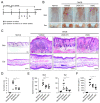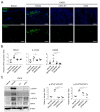Mesenchymal Stem Cells and Extracellular Vesicles Derived from Canine Adipose Tissue Ameliorates Inflammation, Skin Barrier Function and Pruritus by Reducing JAK/STAT Signaling in Atopic Dermatitis
- PMID: 35563259
- PMCID: PMC9101369
- DOI: 10.3390/ijms23094868
Mesenchymal Stem Cells and Extracellular Vesicles Derived from Canine Adipose Tissue Ameliorates Inflammation, Skin Barrier Function and Pruritus by Reducing JAK/STAT Signaling in Atopic Dermatitis
Abstract
Canine atopic dermatitis (AD) is a common chronic inflammatory skin disorder resulting from imbalance between T lymphocytes. Current canine AD treatments use immunomodulatory drugs, but some of the dogs have limitations that do not respond to standard treatment, or relapse after a period of time. Thus, the purpose of this study was to evaluate the immunomodulatory effect of mesenchymal stem cells derived from canine adipose tissue (cASCs) and cASCs-derived extracellular vesicles (cASC-EVs) on AD. First, we isolated and characterized cASCs and cASCs-EVs to use for the improvement of canine atopic dermatitis. Here, we investigated the effect of cASCs or cASC-EVs on DNCB-induced AD in mice, before using for canine AD. Interestingly, we found that cASCs and cASC-EVs improved AD-like dermatitis, and markedly decreased levels of serum IgE, (49.6%, p = 0.002 and 32.1%, p = 0.016 respectively) epidermal inflammatory cytokines and chemokines, such as IL-4 (32%, p = 0.197 and 44%, p = 0.094 respectively), IL-13 (47.4%, p = 0.163, and 50.0%, p = 0.039 respectively), IL-31 (64.3%, p = 0.030 and 76.2%, p = 0.016 respectively), RANTES (66.7%, p = 0.002 and 55.6%, p = 0.007) and TARC (64%, p = 0.016 and 86%, p = 0.010 respectively). In addition, cASCs or cASC-EVs promoted skin barrier repair by restoring transepidermal water loss, enhancing stratum corneum hydration and upregulating the expression levels of epidermal differentiation proteins. Moreover, cASCs or cASC-EVs reduced IL-31/TRPA1-mediated pruritus and activation of JAK/STAT signaling pathway. Taken together, these results suggest the potential of cASCs or cASC-EVs for the treatment of chronic inflammation and damaged skin barrier in AD or canine AD.
Keywords: atopic dermatitis; canine; extracellular vesicle; inflammation; mesenchymal stem cell; pruritus; skin barrier function.
Conflict of interest statement
S.Y.K. and T.H.Y. are employees of GNG CELL Co., Ltd., R&D Center. T.-W.C. is CEO and stockholder of JIN BioCell Co., Ltd. Sang-Soo Lee who is funder and CEO (founder) of GNG CELL Co., Ltd., had no role in data collection, design, analyses, interpretation of data, manuscript preparation, or publication. All rights is reserved by GNG CELL, although this paper was written by supporting technique and idea through a joint research contract (GNG CELL Co./Kyungpook National University/JIN BioCell Co., Ltd.). No potential conflict of interest was reported by all other authors.
Figures





Similar articles
-
Canine Mesenchymal-Stem-Cell-Derived Extracellular Vesicles Attenuate Atopic Dermatitis.Animals (Basel). 2023 Jul 6;13(13):2215. doi: 10.3390/ani13132215. Animals (Basel). 2023. PMID: 37444013 Free PMC article.
-
Extracellular vesicles from IFN-γ-primed mesenchymal stem cells repress atopic dermatitis in mice.J Nanobiotechnology. 2022 Dec 10;20(1):526. doi: 10.1186/s12951-022-01728-8. J Nanobiotechnology. 2022. PMID: 36496385 Free PMC article.
-
Baicalin ameliorates 2,4-dinitrochlorobenzene-induced atopic dermatitis-like skin lesions in mice through modulating skin barrier function, gut microbiota and JAK/STAT pathway.Bioorg Chem. 2022 Feb;119:105538. doi: 10.1016/j.bioorg.2021.105538. Epub 2021 Dec 6. Bioorg Chem. 2022. PMID: 34929516
-
Potential Natural Biomolecules Targeting JAK/STAT/SOCS Signaling in the Management of Atopic Dermatitis.Molecules. 2022 Jul 21;27(14):4660. doi: 10.3390/molecules27144660. Molecules. 2022. PMID: 35889539 Free PMC article. Review.
-
JAK-STAT signaling pathway in the pathogenesis of atopic dermatitis: An updated review.Front Immunol. 2022 Dec 8;13:1068260. doi: 10.3389/fimmu.2022.1068260. eCollection 2022. Front Immunol. 2022. PMID: 36569854 Free PMC article. Review.
Cited by
-
Canine Stem Cell-derived Exosomes for Lung Inflammation: Efficacy of Intratracheal Versus Intravenous Administration in an Acute Lung Injury Mouse Model.In Vivo. 2025 Jan-Feb;39(1):228-235. doi: 10.21873/invivo.13821. In Vivo. 2025. PMID: 39740873 Free PMC article.
-
Effects of MSC-derived extracellular vesicles and dupilumab on the spleen and skin in a house dust mite-induced atopic dermatitis model.Stem Cells Transl Med. 2025 Jul 24;14(8):szaf030. doi: 10.1093/stcltm/szaf030. Stem Cells Transl Med. 2025. PMID: 40704968 Free PMC article.
-
Mesenchymal stem cells-derived small extracellular vesicles and apoptotic extracellular vesicles for wound healing and skin regeneration: a systematic review and meta-analysis of preclinical studies.J Transl Med. 2025 Mar 24;23(1):364. doi: 10.1186/s12967-024-05744-0. J Transl Med. 2025. PMID: 40128791 Free PMC article.
-
Beyond Canine Adipose Tissue-Derived Mesenchymal Stem/Stromal Cells Transplantation: An Update on Their Secretome Characterization and Applications.Animals (Basel). 2023 Nov 19;13(22):3571. doi: 10.3390/ani13223571. Animals (Basel). 2023. PMID: 38003188 Free PMC article. Review.
-
Therapeutic roles of natural and engineered mesenchymal stem cells and extracellular vesicles in atopic dermatitis.Regen Ther. 2025 Jun 4;30:123-135. doi: 10.1016/j.reth.2025.05.009. eCollection 2025 Dec. Regen Ther. 2025. PMID: 40521136 Free PMC article. Review.
References
MeSH terms
Substances
Grants and funding
LinkOut - more resources
Full Text Sources
Medical

